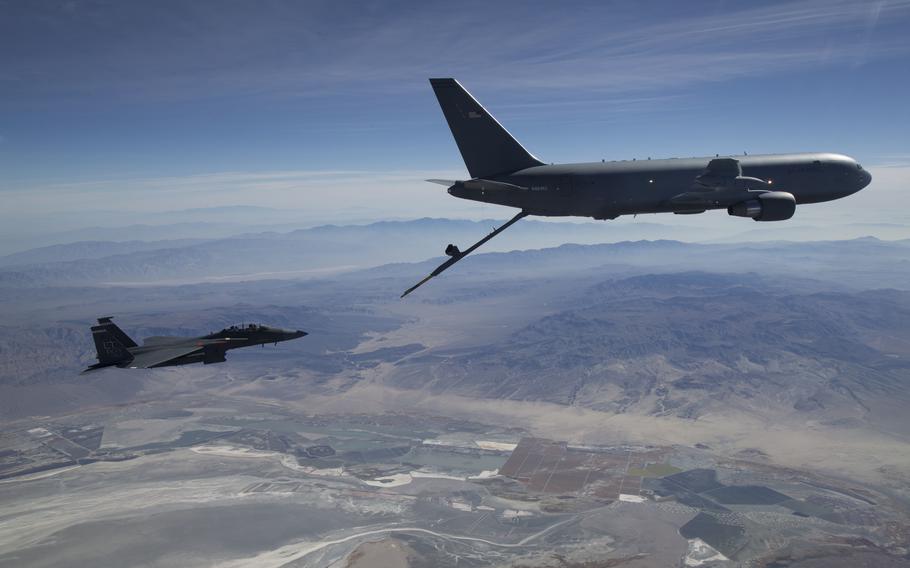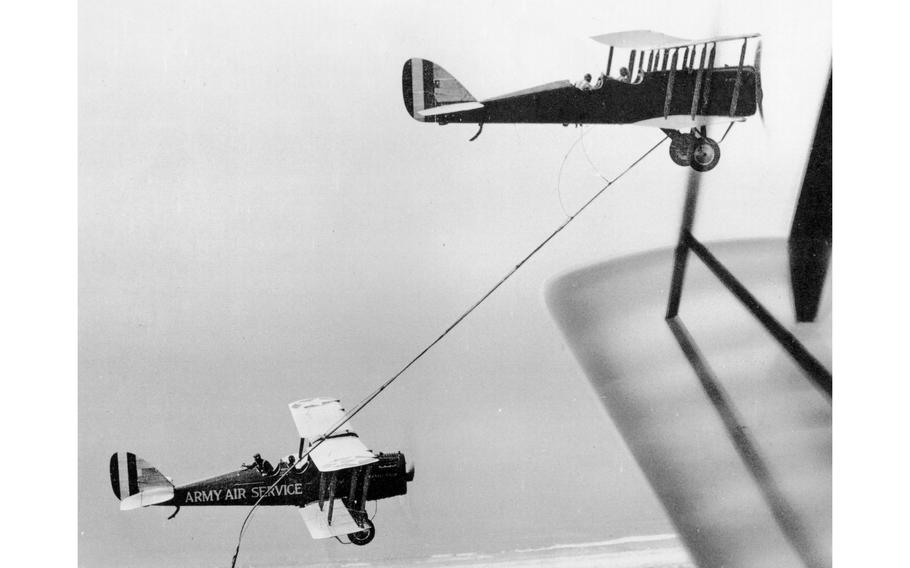
A KC-46A Pegasus aerial refueling aircraft connects with an F-15 Strike Eagle test aircraft from Eglin Air Force Base, Fla., in 2018. (Michael Jackson/U.S. Air Force)
WASHINGTON — The Air Force will perform dozens of commemorative flyovers across the United States on Tuesday to celebrate 100 years of the military refueling aircraft in-flight, service officials said.
The Army Air Service — a predecessor to the Air Force — developed a way in the 1920s to extend flight missions by allowing aircraft, which then were strictly propeller-driven, to stay in the air without landing to refuel.
“Air refueling embodies our resolve to defend freedom and project power, leaving an indelible mark on aviation history,” said Gen. Mike Minihan, commander of the Air Force Air Mobility Command. “It connects our strategic vision with operational reality, ensuring we can reach any corner of the globe with unwavering speed.”
On Tuesday, more than 150 tankers from 26 installations will perform flyovers at major landmarks, population centers and state capitals in all 50 states, the Air Force said. A KC-135 Stratotanker from the Iowa Air National Guard, for example, will perform flyovers with F-16s in the Missouri River Valley region — and Alaska’s 168th Wing will fly over many locations with KC-135s, including Fort Yukon in the east-central part of the state, Deadhorse in the far north and Kenai in the far south.
In South Dakota, flyovers are planned for Pierre, Badlands National Park and Mount Rushmore. In North Dakota, flyovers will be seen in Bismarck and Theodore Roosevelt National Park. Elsewhere, tankers will fly over statehouses from coast to coast, the Air Force said.
Though in-flight refueling might seem routine today, doing it for the first time was a logistical challenge for aviators of the early 20th century, according to the National Museum of the United States Air Force. Recognizing the need to keep planes aloft for longer than their fuel tanks allowed, pilots at Rockwell Field in San Diego — now part of Naval Air Station North Island — set out to achieve mid-flight refueling in the early 1920s. They succeeded, with the milestone coming just months after Lts. John Macready and Oakley Kelly set a world aviation endurance record of more than 35 hours in a Fokker T-2 airplane — a record that might have been more impressive if they hadn’t been forced to the ground to refuel.

Two pilots with the Army Air Service pump fuel through a hose from one plane to another in the sky over San Diego on June 27, 1923. The Air Force will commemorate the event on Tuesday with flyovers in all 50 states. (U.S. Air Force)
The first in-flight refueling occurred on June 27, 1923, between two DH-4Bs. During that historic event, Air Service 1st Lt. Virgil Hine and 1st Lt. Frank Seifert successfully pumped fuel from one plane, through a hose, to the other below carrying Capt. Lowell Smith and 1st Lt. John Richter. A few weeks later, Smith and Richter set a new endurance record of more than 37 hours, which involved more than a dozen refueling contacts, according to the museum.
“During this flight, they set 16 new world records for distance, speed and duration,” according to the museum. “On Oct. 25, 1923, Smith and Richter flew nonstop from the Canadian to the Mexican border, a distance of 1,250 miles, by being refueled three times while in the air. The theory of extending the range of an airplane by mid-air refueling became a demonstrated fact.”
Today, the military has a fleet of refueling aircraft, including the workhorse KC-135, which has been in service since the 1950s, and newer tankers such as the KC-46 Pegasus and KC-10 Extender. The KC-46 entered service in 2019 and was built to help replace the aging KC-135 fleet.
“It is an honor to serve and represent the legacy of those who served before us on an important mission of refueling,” Capt. Steven Billa, a KC-135 pilot in Alaska’s 168th Wing, said of participating in the flyovers.
“One hundred years later, the United States Air Force celebrates these airmen, and looks to the next generation to bring diversity of thought, push boundaries and find solutions beyond the status quo,” said the Air Force’s Air Mobility Command. “[We] salute the visionaries who’ve done the impossible, while inspiring the next generation of dreamers.”